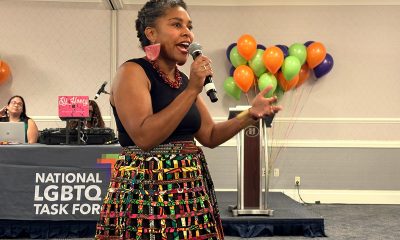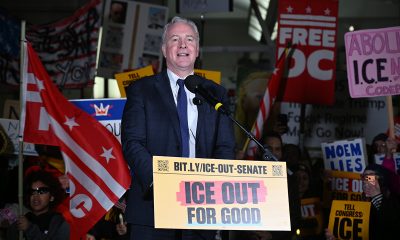National
‘Don’t Ask, Don’t Tell’ comes to an end
Burden on gay, lesbian service members lifted Tuesday


An estimated 2 million U.S. service members were trained on gay-related issues in the run-up to next Tuesday’s lifting of the military’s gay ban. (Washington Blade file photo by Michael Key)
As gay and lesbian troops await the end of the 18-year-old ban on openly gay service members on Tuesday, observers say the change will have significant impact beyond the military.
“Don’t Ask, Don’t Tell” will finally be lifted from the books thanks to the certification of repeal that President Obama, Defense Secretary Leon Panetta and Chairman of the Joint Chiefs of Staff Adm. Mike Mullen sent to Congress on July 22. In accordance with the repeal law that President Obama signed in December, certification started a 60-day timeclock for the end of the ban on Sept. 20.
Aaron Belkin, author of “How We Won,” a book on the lessons learned for progressive causes resulting from “Don’t Ask, Don’t Tell” repeal, said the end of the military’s gay ban represents the end of what he called the “political paranoia” that led to the institution of the law in 1993.
“Just abstracting away from the question of LGBT rights that’s a danger to every American citizen,” Belkin said. “Sept. 20 is about the cultural change for the military and the political change for gay and lesbian troops … but I would say, even more importantly, it’s a moment when truth and fairness trumped paranoia, and that’s just critical.”
Jeff Krehely, director of the LGBT research and communications project at the Center for American Progress, said allowing open service will be significant for many Americans.
“‘Don’t Ask, Don’t Tell’ repeal is huge and tremendous, but I think there are much larger implications for society because a lot of people really respect the military,” Krehely said.
Observers agree the process that led to the end of “Don’t Ask, Don’t Tell” will have a lasting impact as well.
Alex Nicholson, executive director of Servicemembers United, said the training in which service members have been participating will have significant influence on the perspective with which troops — and the American public at large — view gay and lesbian people.
“They really took the time to train and educate the force on the various assets of this policy and hypotheticals,” Nicholson said. “It was an hour of instruction on gays and lesbians, on gay families, on gay partners and it was a really a normalization routine. It was really exposed to millions of America’s most conservative youth to the normality of gays and lesbians.”
Among the situations that the training addressed, Nicholson said, were gay troops holding hands, going on dates or participating in military events with their partners. Nearly 2 million service members received the “Don’t Ask, Don’t Tell” training before certification took place on July 22, according to the Pentagon.
Workplace discrimination against LGBT people could be an issue that gains new focus after “Don’t Ask, Don’t Tell” repeal. No federal law exists to protect LGBT workers against discrimination. Firing someone for being gay is legal in 29 states and firing someone for being transgender is legal in 35 states.
Krehely said open service could generate support for the Employment Non-Discrimination Act, which would prohibit discrimination against LGBT workers in most situations in the public and private workforce, or encourage other employers to add protections for LGBT workers.
“The military is probably one of the biggest and most visible workplaces in our country,” Krehely said. “I think Sept. 20 is a clear indication that this discrimination should not be there any longer, and that we need to move forward on ENDA, and educate people about the broader workplace issues that we’re up against.”
Despite the potential for long-term impact, advocates say the change resulting in the end of “Don’t Ask, Don’t Tell” won’t be immediately apparent and any impact of any lifting the gay ban will be more drawn out.
Krehely said the end of “Don’t Ask, Don’t Tell” next week won’t mean the “world changes necessarily” on Tuesday.
“I think that it’s just people who want to serve their country will want to do that without living in fear,” Krehely said. “That’s the biggest change. It may not be visible, but it’s really important to those people and it’s really important to the military itself.”
Nicholson predicted Tuesday will be a “non-event” and said many gay service members will choose not to come out even though they won’t be in danger of dismissal now that the military’s gay ban is off the books.
“I think you’ll see a good number of them who decide not to come out,” Nicholson said. “I think the post-repeal military is going to resemble any conservative American workplace where individuals judge their willingness and their comfort level in coming out.”
According to the most recent findings from the Williams Institute at the University of California in Los Angeles, an estimated 48,500 lesbians, gay men and bisexuals serve on active duty or in the ready reserve in the U.S. military, while an additional 22,000 are in standby and retired reserve forces. These 70,500 service members make up 2.2 percent of the total force.
But what will happen to those service members who choose to be public about their sexual orientation? Will service members patronize their local gay bars while in uniform? Will Pride parades include contingents of openly gay troops?
Some gay troops have already started brandishing their military credentials during Pride celebrations. In July, about 200 active-duty troops and veterans marched in San Diego’s Pride parade. They weren’t wearing uniforms, but T-shirts indicating their branch of service. The event was the first time a military contingent participated in a Pride celebration in the United States.
Nicholson said that the standards that apply to straight service members with regard to uniforms will also apply to gay troops — so wearing the uniform may not be appropriate in some circumstances.
“Unless it’s some unusual circumstances, service members don’t wear their uniforms out to the bar,” Nicholson said. “I can pretty much guarantee that violations of long-standing and well-understood regulations like that for the sake of publicity is going to be frowned upon by gay troops because the community consensus is they want to blend in like everyone else and not have any special treatment.”
Nonetheless, gay troops will undoubtedly be visible in the post-repeal world. Belkin said the higher visibility of gay troops — and their relationships — following the end of “Don’t Ask, Don’t Tell” will add to the political pressure to advance the fight for same-sex marriage.
“We’re going to see gay and lesbian service members coming back from the Middle East and talking about the importance of marriage equality, and, very tragically, we’re going to see gay and lesbian service members fall in the battlefield and their partners, husbands and wives will not be dealt any benefits their straight counterparts have,” Belkin said. “That is going to illustrate for the public in a much more vivid way the stakes of the marriage debate.”
What’s the next frontier for those who worked to repeal “Don’t Ask, Don’t Tell?” Securing benefits for gay and lesbian troops is the next step advocates plan to take after the gay ban is lifted from the books.
The Defense of Marriage Act, which prohibits federal recognition of same-sex marriage, prevents the military from offering benefits to gay troops, such as health care benefits. But other benefits related to housing and legal services could be changed administratively.
Krehely said benefits for gay troops will be among the issues advocacy groups will be pushing for in the post-repeal world.
“I think that there are still some implementation issues that need to be worked out in terms of benefits and housing, and I think that’s something advocacy organizations and research groups are going to keep trying to make some progress on,” Krehely said.
Florida
DNC slams White House for slashing Fla. AIDS funding
State will have to cut medications for more than 16,000 people
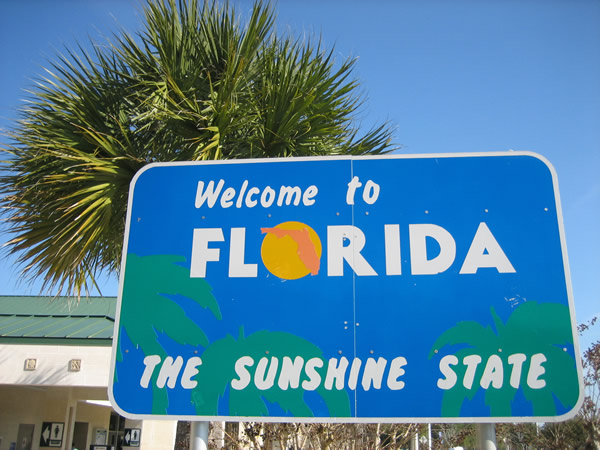
The Trump-Vance administration and congressional Republicans’ “Big Beautiful Bill” could strip more than 10,000 Floridians of life-saving HIV medication.
The Florida Department of Health announced there would be large cuts to the AIDS Drug Assistance Program in the Sunshine State. The program switched from covering those making up to 400 percent of the Federal Poverty Level, which was anyone making $62,600 or less, in 2025, to only covering those making up to 130 percent of the FPL, or $20,345 a year in 2026.
Cuts to the AIDS Drug Assistance Program, which provides medication to low-income people living with HIV/AIDS, will prevent a dramatic $120 million funding shortfall as a result of the Big Beautiful Bill according to the Florida Department of Health.
The International Association of Providers of AIDS Care and Florida Surgeon General Joseph Ladapo warned that the situation could easily become a “crisis” without changing the current funding setup.
“It is a serious issue,” Ladapo told the Tampa Bay Times. “It’s a really, really serious issue.”
The Florida Department of Health currently has a “UPDATES TO ADAP” warning on the state’s AIDS Drug Assistance Program webpage, recommending Floridians who once relied on tax credits and subsidies to pay for their costly HIV/AIDS medication to find other avenues to get the crucial medications — including through linking addresses of Florida Association of Community Health Centers and listing Florida Non-Profit HIV/AIDS Organizations rather than have the government pay for it.
HIV disproportionately impacts low income people, people of color, and LGBTQ people
The Tampa Bay Times first published this story on Thursday, which began gaining attention in the Sunshine State, eventually leading the Democratic Party to, once again, condemn the Big Beautiful Bill pushed by congressional republicans.
“Cruelty is a feature and not a bug of the Trump administration. In the latest attack on the LGBTQ+ community, Donald Trump and Florida Republicans are ripping away life-saving HIV medication from over 10,000 Floridians because they refuse to extend enhanced ACA tax credits,” Democratic National Committee spokesperson Albert Fujii told the Washington Blade. “While Donald Trump and his allies continue to make clear that they don’t give a damn about millions of Americans and our community, Democrats will keep fighting to protect health care for LGBTQ+ Americans across the country.”
More than 4.7 million people in Florida receive health insurance through the federal marketplace, according to KKF, an independent source for health policy research and polling. That is the largest amount of people in any state to be receiving federal health care — despite it only being the third most populous state.
Florida also has one of the largest shares of people who use the AIDS Drug Assistance Program who are on the federal marketplace: about 31 percent as of 2023, according to the Tampa Bay Times.
“I can’t understand why there’s been no transparency,” David Poole also told the Times, who oversaw Florida’s AIDS program from 1993 to 2005. “There is something seriously wrong.”
The National Alliance of State and Territorial AIDS Directors estimates that more than 16,000 people will lose coverage
U.S. Supreme Court
Competing rallies draw hundreds to Supreme Court
Activists, politicians gather during oral arguments over trans youth participation in sports
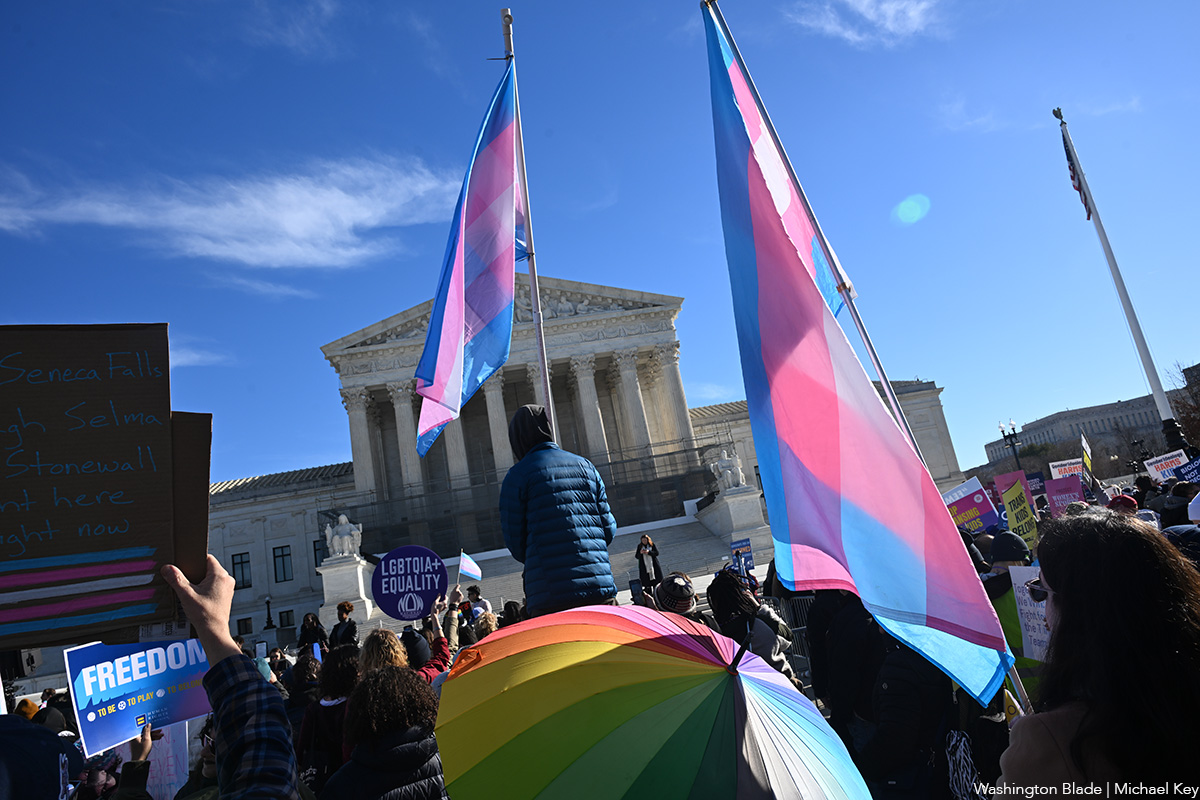
Hundreds of supporters and opponents of trans rights gathered outside of the United States Supreme Court during oral arguments for Little v. Hecox and West Virginia v. B.P.J. on Tuesday. Two competing rallies were held next to each other, with politicians and opposing movement leaders at each.
“Trans rights are human rights!” proclaimed U.S. Sen. Ed Markey (D-Mass.) to the crowd of LGBTQ rights supporters. “I am here today because trans kids deserve more than to be debated on cable news. They deserve joy. They deserve support. They deserve to grow up knowing that their country has their back.”
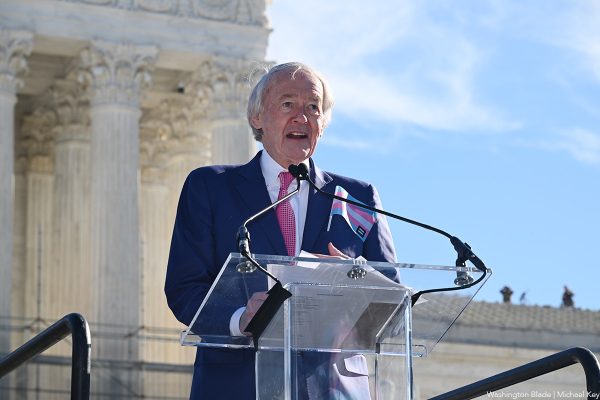
“And I am here today because we have been down this hateful road before,” Markey continued. “We have seen time and time again what happens when the courts are asked to uphold discrimination. History eventually corrects those mistakes, but only after the real harm is done to human beings.”
View on Threads
U.S. Education Secretary Linda McMahon spoke at the other podium set up a few feet away surrounded by signs, “Two Sexes. One Truth.” and “Reality Matters. Biology Matters.”
“In just four years, the Biden administration reversed decades of progress,” said McMahon. “twisting the law to urge that sex is not defined by objective biological reality, but by subjective notion of gender identity. We’ve seen the consequences of the Biden administration’s advocacy of transgender agendas.”
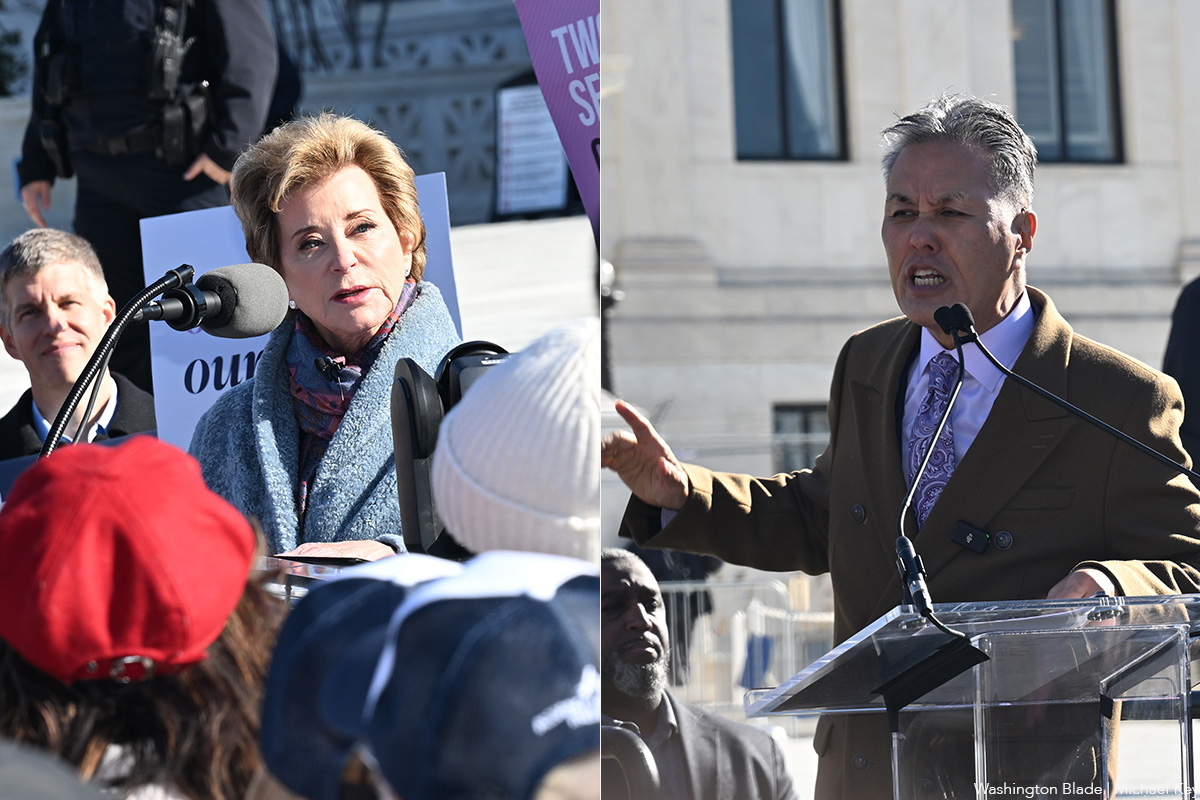
U.S. Rep. Mark Takano (D-Calif.), chair of the Congressional Equality Caucus, was introduced on the opposing podium during McMahon’s remarks.
“This court, whose building that we stand before this morning, did something quite remarkable six years ago.” Takano said. “It did the humanely decent thing, and legally correct thing. In the Bostock decision, the Supreme Court said that trans employees exist. It said that trans employees matter. It said that Title VII of the Civil Rights Act protects employees from discrimination based on sex, and that discrimination based on sex includes discrimination based on gender identity and sexual orientation. It recognizes that trans people have workplace rights and that their livelihoods cannot be denied to them, because of who they are as trans people.”
“Today, we ask this court to be consistent,” Takano continued. “If trans employees exist, surely trans teenagers exist. If trans teenagers exist, surely trans children exist. If trans employees have a right not to be discriminated against in the workplace, trans kids have a right to a free and equal education in school.”
Takano then turned and pointed his finger toward McMahon.
“Did you hear that, Secretary McMahon?” Takano addressed McMahon. “Trans kids have a right to a free and equal education! Restore the Office of Civil Rights! Did you hear me Secretary McMahon? You will not speak louder or speak over me or over these people.”
Both politicians continued their remarks from opposing podiums.
“I end with a message to trans youth who need to know that there are adults who reject the political weaponization of hate and bigotry,” Takano said. “To you, I say: you matter. You are not alone. Discrimination has no place in our schools. It has no place in our laws, and it has no place in America.”
U.S. Supreme Court
Supreme Court hears arguments in two critical cases on trans sports bans
Justices considered whether laws unconstitutional under Title IX.
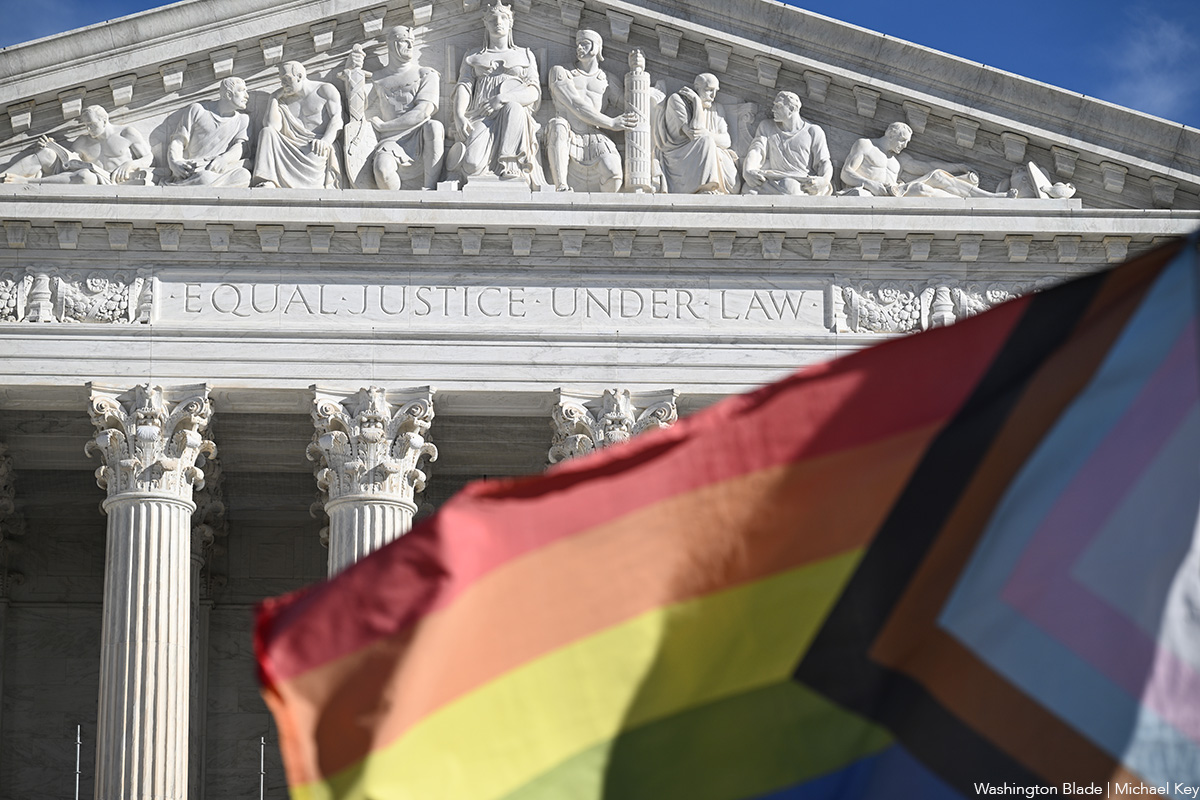
The Supreme Court heard two cases today that could change how the Equal Protection Clause and Title IX are enforced.
The cases, Little v. Hecox and West Virginia v. B.P.J., ask the court to determine whether state laws blocking transgender girls from participating on girls’ teams at publicly funded schools violates the 14th Amendment’s Equal Protection Clause and Title IX. Once decided, the rulings could reshape how laws addressing sex discrimination are interpreted nationwide.
Chief Justice John Roberts raised questions about whether Bostock v. Clayton County — the landmark case holding that Title VII of the Civil Rights Act of 1964 protects employees from discrimination based on sexual orientation or gender identity — applies in the context of athletics. He questioned whether transgender girls should be considered girls under the law, noting that they were assigned male at birth.
“I think the basic focus of the discussion up until now, which is, as I see it anyway, whether or not we should view your position as a challenge to the distinction between boys and girls on the basis of sex or whether or not you are perfectly comfortable with the distinction between boys and girls, you just want an exception to the biological definition of girls.”
“How we approach the situation of looking at it not as boys versus girls but whether or not there should be an exception with respect to the definition of girls,” Roberts added, suggesting the implications could extend beyond athletics. “That would — if we adopted that, that would have to apply across the board and not simply to the area of athletics.”
Justice Clarence Thomas echoed Roberts’ concerns, questioning how sex-based classifications function under Title IX and what would happen if Idaho’s ban were struck down.
“Does a — the justification for a classification as you have in Title IX, male/female sports, let’s take, for example, an individual male who is not a good athlete, say, a lousy tennis player, and does not make the women’s — and wants to try out for the women’s tennis team, and he said there is no way I’m better than the women’s tennis players. How is that different from what you’re being required to do here?”
Justice Samuel Alito addressed what many in the courtroom seemed reluctant to state directly: the legal definition of sex.
“Under Title IX, what does the term ‘sex’ mean?” Alito asked Principal Deputy Solicitor General Hashim Mooppan, who was arguing in support of Idaho’s law. Mooppan maintained that sex should be defined at birth.
“We think it’s properly interpreted pursuant to its ordinary traditional definition of biological sex and think probably given the time it was enacted, reproductive biology is probably the best way of understanding that,” Mooppan said.
Justice Sonia Sotomayor pushed back, questioning how that definition did not amount to sex discrimination against Lindsay Hecox under Idaho law. If Hecox’s sex is legally defined as male, Sotomayor argued, the exclusion still creates discrimination.
“It’s still an exception,” Sotomayor said. “It’s a subclass of people who are covered by the law and others are not.”
Justice Elena Kagan highlighted the broader implications of the cases, asking whether a ruling for the states would impose a single definition of sex on the 23 states that currently have different laws and standards. The parties acknowledged that scientific research does not yet offer a clear consensus on sex.
“I think the one thing we definitely want to have is complete findings. So that’s why we really were urging to have a full record developed before there were a final judgment of scientific uncertainty,” said Kathleen Harnett, Hecox’s legal representative. “Maybe on a later record, that would come out differently — but I don’t think that—”
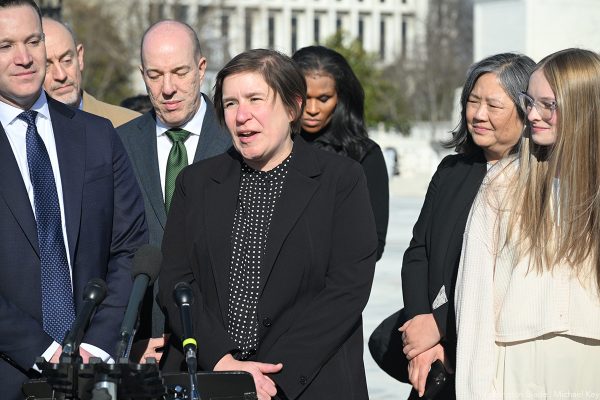
“Just play it out a little bit, if there were scientific uncertainty,” Kagan responded.
Justice Brett Kavanaugh focused on the impact such policies could have on cisgender girls, arguing that allowing transgender girls to compete could undermine Title IX’s original purpose.
“For the individual girl who does not make the team or doesn’t get on the stand for the medal or doesn’t make all league, there’s a — there’s a harm there,” Kavanaugh said. “I think we can’t sweep that aside.”
Justice Amy Coney Barrett questioned whether Idaho’s law discriminated based on transgender status or sex.
“Since trans boys can play on boys’ teams, how would we say this discriminates on the basis of transgender status when its effect really only runs towards trans girls and not trans boys?”
Harnett responded, “I think that might be relevant to a, for example, animus point, right, that we’re not a complete exclusion of transgender people. There was an exclusion of transgender women.”
Justice Ketanji Brown Jackson challenged the notion that explicitly excluding transgender people was not discrimination.
“I guess I’m struggling to understand how you can say that this law doesn’t discriminate on the basis of transgender status. The law expressly aims to ensure that transgender women can’t play on women’s sports teams… it treats transgender women different than — than cis-women, doesn’t it?”
Idaho Solicitor General Alan Hurst urged the court to uphold his state’s ban, arguing that allowing participation based on gender identity — regardless of medical intervention — would deny opportunities to girls protected under federal law.
Hurst emphasized that biological “sex is what matters in sports,” not gender identity, citing scientific evidence that people assigned male at birth are predisposed to athletic advantages.
Joshua Block, representing B.P.J., was asked whether a ruling in their favor would redefine sex under federal law.
“I don’t think the purpose of Title IX is to have an accurate definition of sex,” Block said. “I think the purpose is to make sure sex isn’t being used to deny opportunities.”
Becky Pepper-Jackson, identified as plaintiff B.P.J., the 15-year-old also spoke out.
“I play for my school for the same reason other kids on my track team do — to make friends, have fun, and challenge myself through practice and teamwork,” said Pepper-Jackson. “And all I’ve ever wanted was the same opportunities as my peers. But in 2021, politicians in my state passed a law banning me — the only transgender student athlete in the entire state — from playing as who I really am. This is unfair to me and every transgender kid who just wants the freedom to be themselves.”
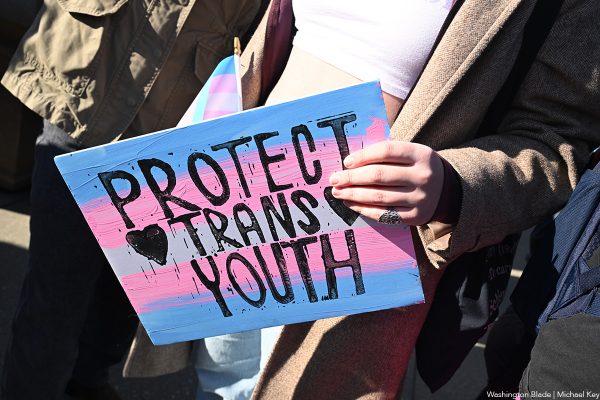
Outside the court, advocates echoed those concerns as the justices deliberated.
“Becky simply wants to be with her teammates on the track and field team, to experience the camaraderie and many documented benefits of participating in team sports,” said Sasha Buchert, counsel and Nonbinary & Transgender Rights Project director at Lambda Legal. “It has been amply proven that participating in team sports equips youth with a myriad of skills — in leadership, teamwork, confidence, and health. On the other hand, denying a student the ability to participate is not only discriminatory but harmful to a student’s self-esteem, sending a message that they are not good enough and deserve to be excluded. That is the argument we made today and that we hope resonated with the justices of the Supreme Court.”
“This case is about the ability of transgender youth like Becky to participate in our schools and communities,” said Joshua Block, senior counsel for the ACLU’s LGBTQ & HIV Project. “School athletics are fundamentally educational programs, but West Virginia’s law completely excluded Becky from her school’s entire athletic program even when there is no connection to alleged concerns about fairness or safety. As the lower court recognized, forcing Becky to either give up sports or play on the boys’ team — in contradiction of who she is at school, at home, and across her life — is really no choice at all. We are glad to stand with her and her family to defend her rights, and the rights of every young person, to be included as a member of their school community, at the Supreme Court.”
The Supreme Court is expected to issue rulings in both cases by the end of June.
-

 U.S. Supreme Court5 days ago
U.S. Supreme Court5 days agoSupreme Court hears arguments in two critical cases on trans sports bans
-

 District of Columbia5 days ago
District of Columbia5 days agoRuby Corado sentenced to 33 months in prison
-

 Iran4 days ago
Iran4 days agoGrenell: ‘Real hope’ for gay rights in Iran as result of nationwide protests
-

 Congress4 days ago
Congress4 days agoVan Hollen speaks at ‘ICE Out for Good’ protest in D.C.



